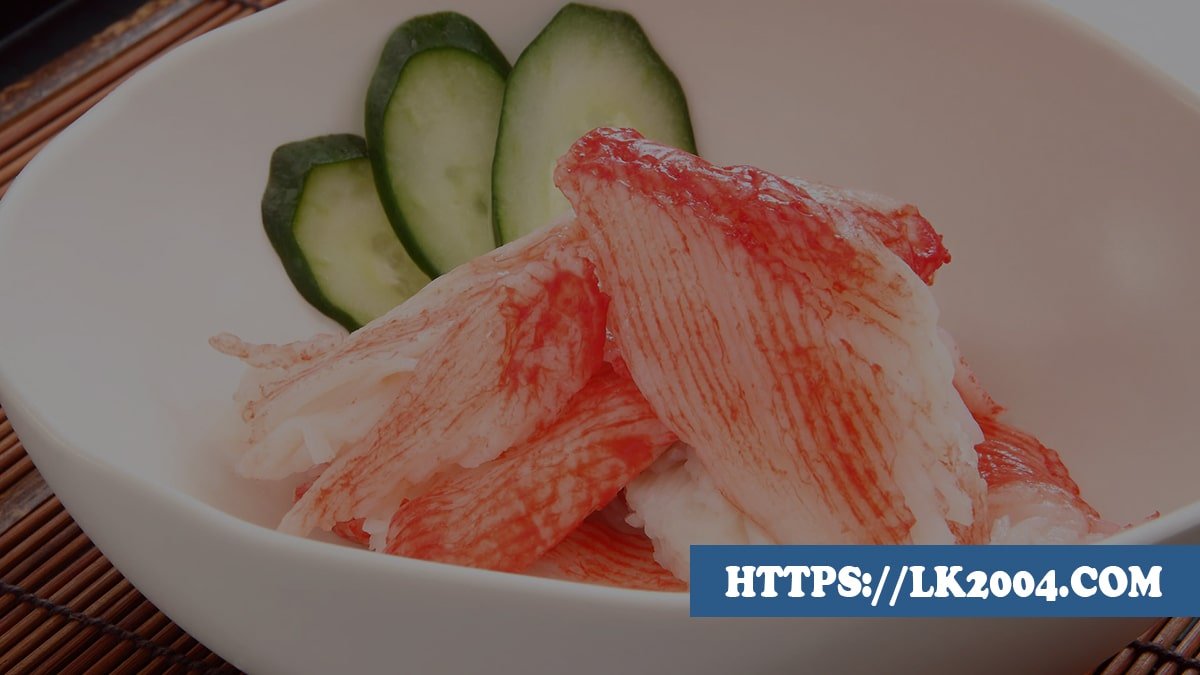Welcome to the fascinating world of Kanikama – a versatile and delicious ingredient that has captured food enthusiasts’ hearts (and taste buds) worldwide. Whether you’re a sushi aficionado, a seafood lover, or simply curious about expanding your culinary horizons, this guide is here to unlock the secrets of Kanikama and introduce you to its wonders. From its intriguing origins to mouthwatering recipes and health benefits, get ready to dive into the captivating realm of Kanikama!
What is Kanikama?
Kanikama, also known as imitation crab meat, is a popular seafood product that has gained widespread popularity for its versatile uses in various cuisines. Contrary to its name, Kanikama does not actually contain any crab meat but is instead made from white fish such as Alaskan pollock. The flesh of the fish is minced and then mixed with starches, egg whites, sugar, salt, and natural or artificial flavorings to create a texture similar to real crab meat.
“Kanikama” originates from Japan and translates to “crab stick.” This faux crab meat was invented by Japanese food scientists in the 1970s as a more affordable alternative to real crab due to its scarcity and high cost. Its mild flavor profile makes it an excellent ingredient for sushi rolls, salads, sandwiches, soups, and dips – adding a touch of seafood taste without overpowering other ingredients.
The History and Origin of Kanikama
Kanikama, a Japanese term combining “kani,” meaning crab, and “kama” for leg, might surprise you with its origins. While it resembles crab meat, Kanikama is actually made from processed white fish like Alaskan Pollock. This imitation crab meat became popular in the 1970s as a cost-effective alternative to real crab.
Creating Kanikama involves mincing the fish flesh into a paste, adding starches and flavorings, shaping it into sticks or flakes, and then coloring it to resemble the vibrant hues of genuine crab legs. Developed in Japan initially by food scientists looking for innovative ways to utilize seafood resources efficiently, Kanikama quickly became a staple ingredient in sushi rolls and various Asian dishes around the globe.
Today, this convenient and versatile seafood product continues to be cherished for its affordability and mild taste that complements a variety of culinary creations.
How is Kanikama Made?
Kanikama, also known as imitation crab meat, is a fascinating product with a unique manufacturing process. To make Kanikama, fish paste is blended with starch, egg whites, sugar, salt, and crab flavoring to mimic the taste and texture of real crab meat. The mixture is then colored with natural red pigment to resemble the appearance of crab legs.
Once the ingredients are well combined, they are shaped into thin sheets and cooked until firm. These sheets are then cooled down and cut into strips or flakes that resemble crab meat strands. The final step involves packaging the Kanikama for distribution to markets worldwide.
The intricate process of creating Kanikama allows seafood lovers to enjoy a tasty alternative to real crab meat at an affordable price. Whether used in sushi rolls or salads, Kanikama offers versatility and convenience in various culinary applications.
Nutritional Value of Kanikama
Kanikama, also known as imitation crab meat, is a versatile ingredient that offers various nutritional benefits. Despite being an imitation product, Kanikama contains protein, making it a good alternative for those looking to reduce their meat consumption. It’s also low in fat and calories compared to real crab meat.
Rich in omega-3 fatty acids from the added fish oil content, Kanikama provides heart-healthy benefits like seafood. Additionally, it contains essential nutrients like vitamins A and C, along with minerals such as calcium and iron. This nutrient profile makes Kanikama a valuable addition to a balanced diet.
For individuals watching their sodium intake, it’s important to note that Kanikama can be high in salt due to the production process. However, low-sodium options are available for those with dietary restrictions or preferences.
When incorporating Kanikama into your meals, consider its nutritional value alongside other ingredients to create well-rounded dishes that support your health goals.
Popular Dishes and Recipes Using Kanikama
Are you ready to explore the delicious world of dishes and recipes using Kanikama? This imitation crab meat is a versatile ingredient that can elevate various meals. From sushi rolls to salads, Kanikama adds a unique flavor and texture to your culinary creations.
One popular dish featuring Kanikama is the California roll. This iconic sushi roll combines avocado, cucumber, rice, seaweed, and Kanikama for a tasty treat that bursts with flavors and colors.
For those looking for a light yet satisfying meal, a Kanikama salad is a perfect choice. Toss together mixed greens, cherry tomatoes, thinly sliced Kanikama strips, and your favorite dressing for a refreshing dish that’s quick and easy to prepare.
If you’re feeling more adventurous in the kitchen, try incorporating Kanikama into stir-fries or pasta dishes for an unexpected twist on classic recipes. The possibilities are endless when it comes to cooking with this versatile ingredient!
Health Benefits of Eating Kanikama
Indulging in Kanikama can offer more than just a delicious taste; it also brings various health benefits. Rich in protein, Kanikama is an excellent choice for those looking to boost their protein intake without consuming high amounts of fat or calories.
Additionally, Kanikama is low in cholesterol and saturated fats, making it a heart-friendly option. Its omega-3 fatty acids content may reduce inflammation and improve overall heart health. Moreover, essential nutrients like vitamins B12 and E enhance energy levels and support immune function.
With its low-calorie count, choosing Kanikama as part of your diet can aid in weight management while still providing essential nutrients. Whether enjoyed independently or incorporated into various dishes, this imitation crab meat can benefit a balanced diet.
Tips for Choosing and Preparing Kanikama
When choosing Kanikama, look for tightly sealed packages that are free from any signs of damage. Check the expiration date to ensure freshness.
Opt for brands known for quality and authenticity to guarantee a delicious dining experience. When preparing Kanikama, gently separate the crab sticks to maintain their shape.
Consider incorporating Kanikama into salads, sushi rolls, or stir-fry dishes for a versatile culinary experience. Experiment with different seasonings and sauces to enhance its flavor profile.
To make a quick and tasty snack, wrap Kanikama in nori seaweed with some rice for homemade sushi rolls. Remember not to overcook Kanikama as it can become rubbery.
Whether you’re a novice cook or an experienced chef, incorporating these tips will help elevate your dishes with the unique taste of Kanikama.
Where to Buy Kanikama and Price Comparison
When purchasing Kanikama, various options are available depending on your location and preferences. Kanikama is found in most grocery stores, especially seafood or Asian food aisles. Additionally, specialized Asian markets or fish markets may also carry a variety of Kanikama products.
Online retailers offer a convenient way to purchase Kanikama if you prefer shopping from the comfort of your home. Websites like Amazon, Walmart, or specific seafood online stores often have a selection of Kanikama products for sale.
Price comparison for Kanikama can vary based on the brand, packaging size, and where you purchase it from. It’s advisable to check different retailers to find the best deals and promotions available at the time of your purchase.
Remember to consider factors like shipping costs if buying online versus potential discounts when buying in bulk from physical stores. Always compare prices wisely before making your final decision on where to buy your favorite Kanikama products.
Conclusion
As we unravel the mysteries of Kanikama, it becomes evident that this imitation crab meat holds a special place in the world of seafood alternatives. From its humble origins to its versatile uses in various dishes, Kanikama offers a unique and flavorful experience for those seeking an alternative to traditional crab meat. Whether enjoyed in sushi rolls, salads, or stir-fries, Kanikama brings a burst of ocean-inspired taste to every bite.
With its impressive nutritional profile and health benefits, including being low in fat and calories while high in protein content, Kanikama is a smart choice for health-conscious individuals looking to enhance their diet. When selecting and preparing Kanikama, choose reputable brands and explore different cooking methods to elevate your culinary creations.
FAQs
Q: Is Kanikama suitable for vegetarians?
A: Kanikama is unsuitable for vegetarians as it is made from fish.
Q: Can I eat Kanikama if I have a shellfish allergy?
A: It’s best to avoid Kanikama if you have a shellfish allergy, as it may trigger similar allergic reactions.
Q: How long does Kanikama last in the refrigerator?
A: Once opened, store Kanikama in an airtight container and consume within 2-3 days for the best quality and taste.
Q: What are some creative ways to use Kanikama in recipes?
A: You can add sliced or shredded kanikama to salads, sushi rolls, and pasta dishes or use it as a topping for pizzas or sandwiches.







